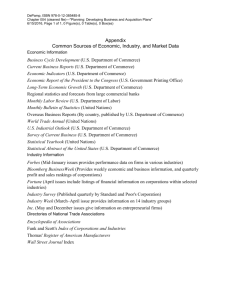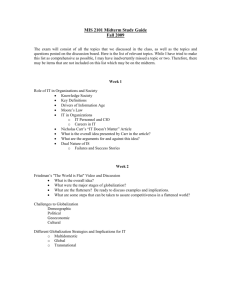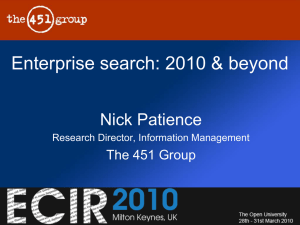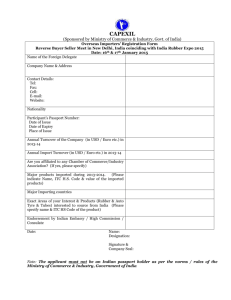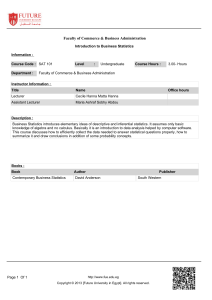E-Commerce, 7e
advertisement
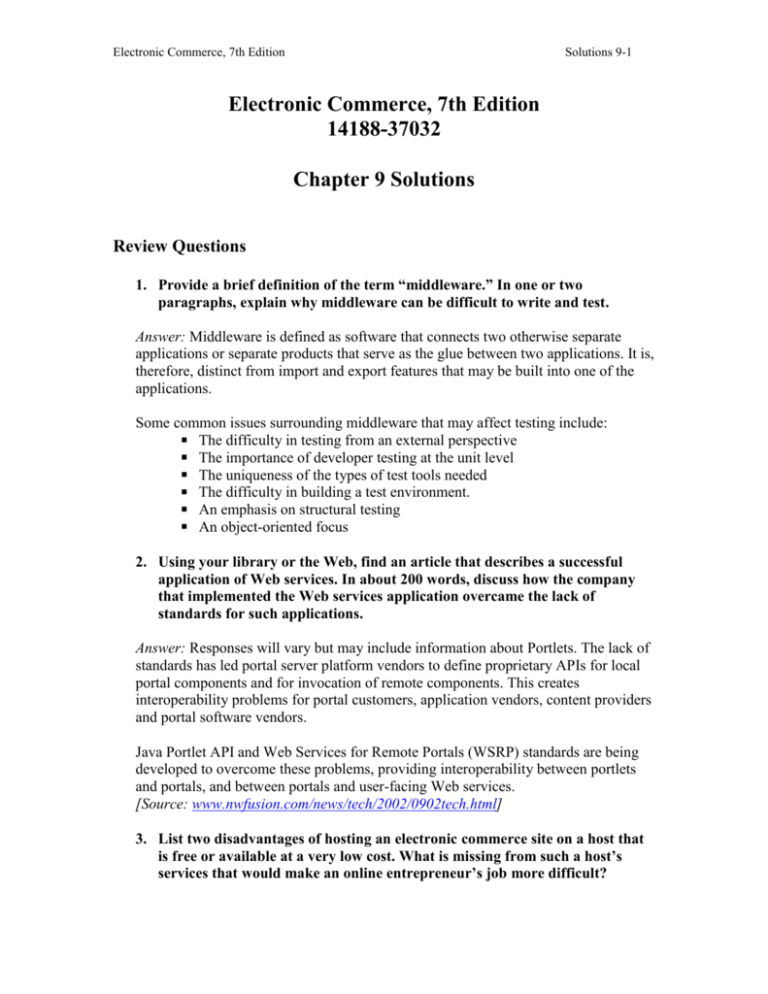
Electronic Commerce, 7th Edition Solutions 9-1 Electronic Commerce, 7th Edition 14188-37032 Chapter 9 Solutions Review Questions 1. Provide a brief definition of the term “middleware.” In one or two paragraphs, explain why middleware can be difficult to write and test. Answer: Middleware is defined as software that connects two otherwise separate applications or separate products that serve as the glue between two applications. It is, therefore, distinct from import and export features that may be built into one of the applications. Some common issues surrounding middleware that may affect testing include: The difficulty in testing from an external perspective The importance of developer testing at the unit level The uniqueness of the types of test tools needed The difficulty in building a test environment. An emphasis on structural testing An object-oriented focus 2. Using your library or the Web, find an article that describes a successful application of Web services. In about 200 words, discuss how the company that implemented the Web services application overcame the lack of standards for such applications. Answer: Responses will vary but may include information about Portlets. The lack of standards has led portal server platform vendors to define proprietary APIs for local portal components and for invocation of remote components. This creates interoperability problems for portal customers, application vendors, content providers and portal software vendors. Java Portlet API and Web Services for Remote Portals (WSRP) standards are being developed to overcome these problems, providing interoperability between portlets and portals, and between portals and user-facing Web services. [Source: www.nwfusion.com/news/tech/2002/0902tech.html] 3. List two disadvantages of hosting an electronic commerce site on a host that is free or available at a very low cost. What is missing from such a host’s services that would make an online entrepreneur’s job more difficult? Electronic Commerce, 7th Edition Solutions 9-2 Answer: Responses will vary, but may include a domain name that is part of the host site as well as not providing a shopping cart. An online business often needs more flexibility than a free or low cost service can provide. “You get what you pay for”! 4. In about 200 words, describe the differences between basic electronic commerce software and midrange electronic commerce software. Discuss at least four differences and give examples of each type of software. Answer: Responses may vary, but should include the less expensive ISP’s vs. inhouse hosting, the lack of features for basic e-commerce software, and the cost of the software itself. The software available in the basic e-commerce level is a fairly simple HTML engine. The larger business software includes Dreamweaver or Visual Studio .NET. This type of software allows for more flexibility and more ‘bells and whistles’. 5. What are the characteristics of large firms conducting both business-tobusiness and business-to-consumer transactions that require more robust and capable electronic commerce systems? Consider the volume and types of transactions and store maintenance activities that differ between a small storefront operation and, for example, an Amazon.com-caliber store. Answer: An enterprise system is fairly expensive and allows for both B2B and B2C. These businesses do a large volume business and are a large Web presence. In addition, since the enterprise system is expensive, only the larger businesses can afford to implement them. 6. Visit the product Web sites to learn more about two of the knowledge management software products discussed in the chapter. In a report of about 300 words addressed to the president of a local university, explain how that university could benefit from an implementation of knowledge management software. Answer: KM software helps companies do four main things: collect and organize information, share the information among users, enhance the ability of users to collaborate, and preserve the knowledge gained through the use of information so that future users can benefit from the learning of current users. KM software includes tools that read electronic documents (in formats such as Microsoft Word or Adobe PDF), scanned paper documents, e-mail messages, and Web pages. KM software often includes powerful search tools that use proprietary semantic and statistical algorithms to help users find the content, human experts, and other resources that can aid them in their research and decision-making tasks. Exercises 1. Your friend Faye Borthick wants to set up a small Web site devoted to gardening. She believes her many years of experience in gardening give her Electronic Commerce, 7th Edition Solutions 9-3 an understanding of the kinds of gardening tools, fertilizers, soil amendment products, herbicides, pesticides, and plants that appeal to the serious gardener. Right now Faye doesn’t want to sell anything. She merely wants to display pages of plant photography, write and store short how-to papers for novice gardeners, and provide links to other gardening tips on the Web. She wants your advice on whether to self-host the Web site or use an ISP (or CSP) to start her endeavor. Use The List or the TopHosts sites to locate information on the cost of using a service provider to host a Web site. Then, estimate what a small Web site might cost in terms of the minimal configuration of hardware and software. Estimate the design and development costs and the annual maintenance costs. Then, select one of the Web server programs. Estimate the cost of a Web connection. Write a 200word summary of everything you think Faye needs to know to use either of the two options (she builds it or she uses a service provider) for creating her site. Answer: Responses will vary but may be similar to the following: Issue Earthlink (T3, Frame Relay, FracT3, T1, DSL) Minimal configuration of hardware and software Design and development Maintenance cost Cost $21.95 per month $7.50 per month $550.00 $20 per page 2. Annette Jackson owns a small crafts store in central Missouri. She wants to expand her store’s reach outside the region to increase her profits and simultaneously reduce her inventory. Annette has been watching her teenage daughter, Kelly, use the Internet to order music CDs and books. After learning from Kelly how simple it is to order from online stores, Annette decided that she needs to create an online store. She asked you to do a little research on how much it might cost in the first year to create a simple store with a catalog of about 100 items. Annette wants you to investigate two CSP offerings and report back to her what you find. Because her store is small, limit your research to basic commerce and mall-style services. You might want to begin your research with sites such as Freemerchant.com or Bigstep. Annette would like to consider the following information for the two CSP offerings you examine: • Costs: initial setup fee, monthly fee, and transaction fees • Amount of disk space the CSP would provide for Annette’s 100-item store • Existence of a search engine within each store • Promotion and marketing opportunities • Customer communications capabilities, such as automated e-mail confirmation of orders Electronic Commerce, 7th Edition Solutions 9-4 • Shopping cart or other order entry mechanism • Storefront-building wizards for creating a new store • Security provisions for transactions • Nature of the domain names available (subdomain of the site or not) • Upload capabilities for product names, descriptions, images, and costs (can they be uploaded from files or databases, or must the merchant enter each item individually?) • Existence of an online user manual for the merchant Produce a report of about 500 words summarizing your findings. Answer: Responses will vary, but should list all of the above. For example, initial setup fee might be $200 with a maintenance fee of $1200. The domain name might run approximately $100. The automated e-mail confirmation will cost Annette $1000, and all payment processing fees should be estimated at 3% of her gross sales. Students should list all fees, understanding that these are approximations. 3. Write a 400-word report summarizing the costs and features of any enterprise-class commerce package for large businesses. You can review a product mentioned in the chapter or one of your own choosing. Pick seven characteristics of the software package and describe them in detail in your report. The Online Companion includes links to several vendors of these products under the Exercise 3 heading. Answer: Responses will vary, but should include such items as shopping cart transactions, automated e-mail, secure transaction processing and fulfillment, etc. Have the students compare and contrast the costs of the chosen product (WebSphere, E-Business Suite) as well as what is available on each one. 4. Review the material in Chapter 4 on customer relationship management (CRM). Then visit the Web sites of Salesforce.com and two or more of the providers of CRM software discussed in this chapter. In about 300 words, critically evaluate Salesforce.com and one of the other CRM software packages by comparing what it accomplishes to the goals of CRM. Answer: One other Web site that may be evaluated is www.strategies.co.uk. E-CRM from Strategies is a secure, web based CRM (Customer Relationship Management) software solution. The CRM software solution is accessed securely via username and password over the Internet and has a base of core functions which can be customized to your exact requirements. All pages within the software solution are located on SSL to encrypt and protect your precious data and the database servers are backed up on a regular, tight schedule every day. Electronic Commerce, 7th Edition Solutions 9-5 Cases Case 1: Ingersoll-Rand Club Car Division 1. Information made available by Club Car division’s new CRM system includes: all customizable options in cart configuration, full pricing information, manufacturing schedules, and delivery date estimates. Specific explanations of the sales benefits of this information will vary, but common benefits to all are convenience, customization, reliability, and scalability. 2. Answers will vary, but possible examples of benefits of the more focused approach include: lower learning curve required to implement system, less training required to transition to new system, increased ability to focus on company priorities to maximize CRM benefits, direct involvement of employees in system development insures a solution appropriate to the organization, increased employee satisfaction with system leads to increase in actual use of the system, and increased customer involvement and satisfaction. 3. Answers will vary, but some potential uses for Web services in the Club Car division CRM system include: make a cart design application available to customers over the Web to explore options and streamline meetings with sales staff, provide e-mail updates to customers who have placed orders about milestones in order fulfillment, and provide some method for sales staff and customers to communicate, emphasize new product features, or exchange ideas via a Web site, message board, or e-mail. Case 2: Web Services for State Government 1. Answers will vary, but should include the main aspects of Web services technology as presented in the chapter beginning on page 413. Emphasis should be placed on interpreting the services for a non-technical audience. 2. Answers will vary based on assessment of which services would be most useful for each department (Attorney General’s Department of Corporation Records, the Tax Administration and Collection Department, the Department of Motor Vehicles, and the Department of Fish and Wildlife Management). 3. Answers will vary based on the results of question two. For each service identified in question two, the relevant costs and benefits listed in the body of this question should be applied. The resulting recommendation for each service should be appropriate based on the cost-benefit analysis.


